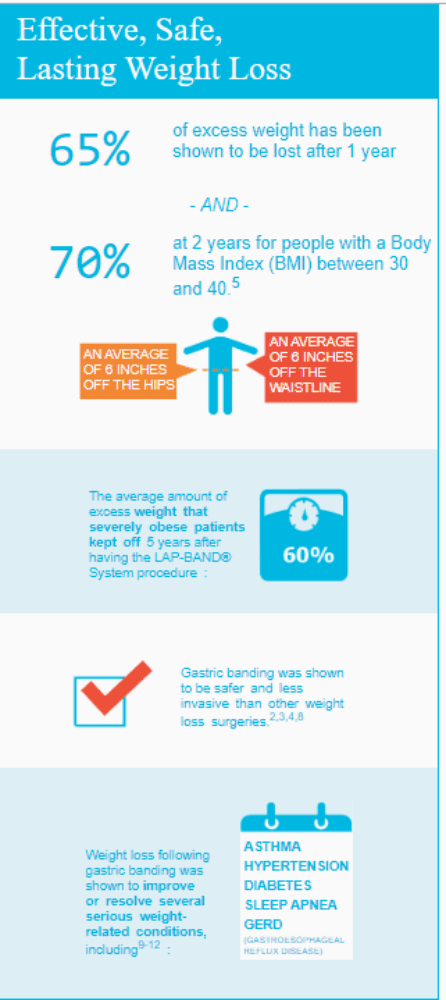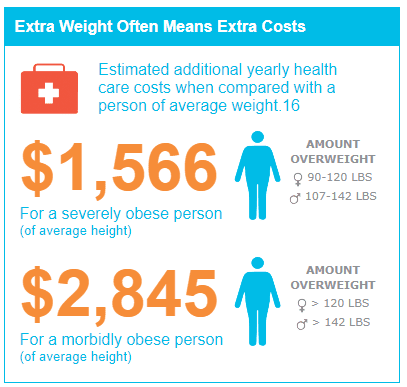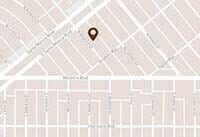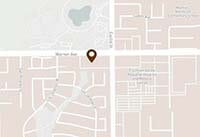

Why LAP-BAND®?
An in-depth guide to choosing this minimally invasive weight loss procedure
PROGRAM GUIDE

Thousands Of People Are Losing Weight With The LAP-BAND® System.
Are You Ready?
You’ve struggled to lose weight for years. You’ve tried the diets, exercise routines, over-the-counter
treatments and meal replacement products. And maybe, like so many others, you’ve been disappointed with the
results. This lack of long-term success can take a toll on your emotional and physical health.
It’s time you considered a better option. If you are committed to transforming your life, the LAP-BAND® System
just may be a fi t for you. Since 1996, hundreds of thousands of people just like you have realized their weight
loss goals with the LAP-BAND® System.1 It’s a safe, minimally invasive, gradual weight loss solution that helps
you lose the weight and keep it off. 2-7

A Proven Weight Loss Solution For So Many
The LAP-BAND® System is a safe and proven weight loss solution that helps you lose the weight and
keep it off. In fact, we hear from people every day who have found success with help from the LAP-BAND® System.
“I trust the band and myself. This is my tool, and I’m in charge. It’s a great partnership.”

Feel Full Faster. Stay Full Longer.

So, what does the LAP-BAND® System actually do? The band is placed around your stomach to reduce your stomach’s
capacity, restricting the amount of food you are able to eat at one time.13 That means you feel full faster and
stay full longer, allowing you to be in control of your weight loss. It’s a safe and effective FDA-approved tool
that will help you gradually lose weight and keep it off long-term.

Minimally Invasive. Minimally Disruptive.
You’re probably wondering what will recovery be like. How long before you can get back to your life? And what
exactly will happen to your body? We understand. Any kind of weight loss procedure can be intimidating.
Fortunately, choosing the LAP-BAND® System can ease these worries. To start, you should know that
the LAP-BAND® System procedure is truly minimally invasive and a great option for folks who need a
more reliable solution than diet and exercise alone, but aren’t prepared for a major surgery. The procedure is
performed laparoscopically and is typically done as an outpatient procedure in less than an hour2, with a
recovery time of about a week.13 A tiny camera allows your specialist to see inside your body as he or she
performs the procedure. Only a few very small incisions are made in the abdomen (about 1.5-2.5 cm each). The
band is placed around your stomach using long, thin instruments.
The LAP-BAND® System is truly unique. It has been designed to be a permanent solution that can be
removed if necessary. It involves no use of metal surgical staples, no amputation of any part of the stomach,
nor any cutting of the intestines. With the LAP-BAND® System there is no permanent alteration to
your body 13,14

“I used to run from life, now I run towards it. I’ve done 39 half marathons, 7 full marathons,
1 ultra (50 mile) marathon, and 2 triathlons in 3 years. Nothing is in my way anymore.”
A Look Ahead At Your New Life:
1 month before your procedure:
Make sure all of your paperwork and clearances are good-to-go! Your specialist and their team can make sure you
have everything you need. Don’t be afraid to ask them any last minute questions you may have. If you have
already scheduled a date for your procedure with your specialist’s team, this would be a good time to request
time off from work if need be. Everyone is different, but fi gure around one week before you can return,
depending on the physical demands of your job and how you feel.
1 week before your procedure:
Start getting your things together, such as a small hospital bag with things that make you feel comfortable,
like loose clothing, slippers, something to read and a pillow. You may fi nd it helpful for the drive home to
hug the pillow close to your belly for those bumps in the road. Ask a close friend or family member to drive
you to and from the hospital, make sure they’re clear on where to go and when. Your nutritionist may have you
on a restricted, or liquid diet at this point, so stock up on everything you’ll need.
The day of your procedure:
Have everything ready. It’s important to stay relaxed. Be on time, or even early so you can arrive at the
hospital feeling prepared. This is a very exciting day!
The fi rst few days after your procedure:
How are you feeling? If you’re up for it, talk to your specialist to make sure you can begin some light
exercise. You may feel sore, but we recommend walking slowly around the house and outside as much as you can.
You will probably be following a liquid-only diet for this fi rst week. Just remember to go slow. This is a
process, and we want you to be safe and healthy in every way.
1 month after your procedure and beyond:
As you adjust to life with the LAP-BAND® System, you’ll be reintroducing foods back into your diet. Some foods
may not agree with you in the beginning, but along the way, you will fi nd what works for you. You will have
already been to your specialist’s offi ce for a follow-up, so your adjustments will begin taking place around
this time.


8 Rules For Life With The LAP-BAND® System
1. Eat only when you are hungry—about three small meals a day.
The LAP-BAND® System creates a small stomach pouch that can hold only about one-quarter cup (approximately 2
ounces) of food.13 If you try to eat more than this at one time, you may become nauseous or vomit. If you
routinely eat too much, the small stomach pouch may stretch. That will cancel the effect of the operation.
Frequent vomiting can also cause certain complications, such as stomach slippage. You need to learn how much
your stomach pouch can hold comfortably and not exceed this amount.
2. Eat slowly and chew very well.
Food can pass through the new stoma (stomach opening) only if it has been chewed into very small pieces. Always
remember to take more time for your meals and chew your food very well.
3. Stop eating as soon as you feel full.
Remember to eat your protein fi rst. By doing so, you are ensuring that you’re getting in the proper fuel. Once
your new stomach pouch is full, yourbody receives a signal that you have eaten enough. It takes time, though,
for you to become aware of this signal, so space out your bites. If you rush through your meal, you may eat
more than you need. This can lead to nausea and vomiting. Take time to eat and enjoy your meal. You want to
feel satiated, not stuffed and uncomfortable. Try to recognize the feeling of fullness—then put your utensils
down.
4. Be active.
This rule is important. Physical activity burns calories and is important to successful weight loss. And don’t
be intimidated by strenuous exercise regimens. Lots of calorie-burning activities can be rewarding and fun.
5. Do not eat between meals.
After a meal, do not eat anything else until the next meal. Eating snacks between meals is one of the major
reasons for weight-loss failure. It is very important to break this habit. Patients with proper “fi ll” levels
do not feel hungry in between meals. If you do, this may be a sign that the LAP-BAND® System is too loose, and
you should tell your doctor.
6. Eat only high-quality food.
Your meals should be high in protein and vitamins. Don’t fi ll your small stomach pouch with “junk” food that
lacks vitamins and other important nutrients. Avoid foods high in fat and sugar. Instead, choose fresh
vegetables, fruit (but not fruit juice), meat, and whole grain cereals. Ask your doctor or dietitian before you
take any vitamin supplements. 7. Drink only low-calorie liquids.
7. Drink only low-calorie liquids.
Drinks, including those containing calories, simply run through the narrow outlet created by the band. If you
drink high calorie liquids, even healthy ones like fruit juices, you may not lose weight, even if you otherwise
follow your diet.
8. Stay on top of your aftercare.
Aftercare is essential to your success. Always keep in contact with your specialist and remain engaged in your
weight loss program.

A Support System Is Essential For Success
This is a big decision, and you need support along the way, not just physically but emotionally too. Friends
and family can be a huge help, but if you live alone, or aren’t really ready to tell people about your
procedure, we recommend asking your specialist to give you a list of groups or meet-ups in your area for people
who are going through the same process as you. They can offer many options to help you along your journey. In
fact, the makers of the LAP-BAND® System are dedicated to supporting you by providing after care tips and
connecting you with others who have found success, just ask!
 “I reached
“I reached
a point where I really needed help. I just couldn’t do it on my own. This is the best decision I’ve ever
made.”
On the other hand, if you’re comfortable doing so, bringing a close friend or family member with you to your
appointments from the beginning can be a wonderful thing. They can be an extra set of ears as well as someone
to turn to if you feel overwhelmed. This is a lifetime process that is designed to achieve long-term
sustainable weight loss. It works over a prolonged period of time as long as you are committed to following
your specialist’s direction for eating, exercise and activity and adjustments. So, it may be necessary to sit
your family down and explain you will need some time to recover. You want to be your best, healthiest self.
And, getting this procedure is the step you need to take to make sure you can set a good example for the whole
family.

- You are at least 30 pounds overweight with a Body Mass Index (BMI) of at least 30 kg/m2 with one or
more obesity related comorbid condition, or, you have a BMI of at least 40 kg/m2. - Your serious weight loss attempts have had only short-term success.
- You are not currently suffering from any other disease that may have caused your excess weight.
- You are at least 18 years old.
- You are prepared to make major changes in your eating habits and lifestyle.
- You do not drink alcohol in excess.
- You are not currently pregnant. (Patients who become pregnant after band placement may require defl ation of
their bands.)
Affording The LAP-BAND® System
The LAP-BAND® System is affordable on most budgets. The actual costs will depend on your individual situation
and several factors, such as your health insurance plan and the specialist and hospital you choose. Over 90% of
the LAP-BAND® System cases performed are reimbursed in full or in part by insurance.15 For help understanding
your insurance coverage and affordable fi nancing options, call 1-800-LAPBAND.

 “Now, I can show
“Now, I can show
my three daughters how to be physically and mentally strong and to love your body. I’m the positive female role
model I’ve always wanted for them.”
The Importance Of Seeing A LAP-BAND® Specialist
Remember, this is your health – and your body – that we’re talking about. Your LAP-BAND® System specialist can
provide answers to your personal questions. They are there to support you before, during, and after your
procedure to provide expert advice, and high-quality aftercare.
You can find added support,
by calling 1-800-LAPBAND or
visiting LAPBAND.com

References:
- Data on File. Apollo Endosurgery, Inc. Austin, TX. December, 2012.
- Hutter Matthew, et al. First Report from the American College of Surgeons Bariatric Surgery Center Network:
Laparoscopic Sleeve Gastrectomy has Morbidity and Effectiveness Positioned Between the Band and the Bypass.
September 2001. - DeMaria Eric, Pate Virginia, Warthen Michael, Winegar Deborah. Baseline data from American Society for
Metabolic and Bariatric Surgery-designated Bariatric Surgery Centers of Excellence using the Bariatric
Outcomes Longitudinal Database. Surgery for Obesity and Related Diseases 6. 2010. - The Longitudinal Assessment of Bariatric Surgery (LABS) Consortium. Perioperative Safety in the
Longitudinal Assessment of Bariatric Surgery. The New England Journal of Medicine Vol. 361 No. 5. July 30,
2009. - Robert Michaelson, Diane K. Murphy, Todd M. Gross, and Scott M. Whitcup. LAP-BAND® for Lower BMI: 2-Year
Results from the Multicenter Pivotal Study. Obesity (2013) 21:1148–1158. - Directions For Use (DFU). LAP-BAND AP® Adjustable Gastric Banding System with OMNIFORM® Design. http://www.
lapband.com/HCP/directions-for-use - Ray James, Ray Shahla. Safety, efficacy, and durability of laparoscopic adjustable gastric banding in a
single surgeon U.S. community practice. Surgery for Obesity and Related Diseases. 2011.
- Needleman BJ, Happel LC. Bariatric surgery: choosing the optimal procedure. Surg Clin N Am.
2008;88:991-1007. - Dixon John, Chapman Leon, O’Brien Paul. Marked Improvement in Asthma after LAP-BAND® Surgery for Morbid
Obesity. Obesity Surgery. 1999. - Dixon John, O’Brien Paul. Health Outcomes of Severely Obese Type 2 Diabetic Subjects 1 Year After
Laparoscopic Adjustable Gastric Banding. Diabetes Care, Volume 25, Number 2. February 2002. - Dixon John, Schachter Linda, O’Brien Paul. Sleep Disturbance and Obesity: Changes Following Surgically
Induced Weight Loss. Arch Intern Med/Vol 161. Jan 8, 2001. - Dixon John, O’Brien Paul. Gastroesophageal Reflux in Obesity: The Effect of LAP-BAND® Placement. Obesity
Surgery. 1999. - The LAP-BAND® System Surgical Aid in the Treatment of Obesity – a decision guide for adults. Austin, TX:
Apollo Endosurgery, Inc; 2014 GRF-00305-00R01. - O’Brien PE. Bariatric surgery: mechanisms, indications and outcomes. J Gastroenterol Hepatol.
2010;25:1358-1365. - Apollo Endosurgery, Inc. Bariatric Surgeon Market Share Tracker. November 2012, Slide 14.
- Dor A, Ferguson C, Langwith C, Tan E. A Heavy Burden: The Individual Costs of Being Overweight and Obese in
the United States. September 2010.





